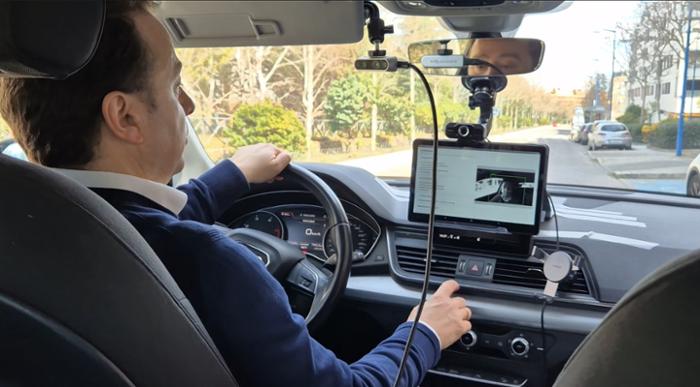AI4DRIVING
AI4DRIVING
Inteligencia Artificial para la colaboración humano-máquina en tareas de conducción (Link)
| Esta web es parte del proyecto de I+D+i / ayuda PID2021-124335OB-C22, financiado por MICIU/AEI/ 10.13039/501100011033/. |
 |
AI4Driving Project Overview:
| Researchers: |
|
| Type: |
|
| Reference: |
|
| Date: |
|
| Funding Entity: |
Description of the project:
In the last decade, Artificial Intelligence (AI) has revolutionized numerous sectors by enhancing traditional processes and improving result quality through general-purpose technologies. AI encompasses a broad spectrum of tools, such as Expert Systems, Evolutionary Algorithms, automatic planning, and Deep Neural Networks. These methods are increasingly vital in domains like the automotive, transport, and electric power industries, particularly in applications like Autonomous Electric Vehicles (AEVs), Advanced Driving Assistance Systems (ADAS), and Vehicle-to-Grid (V2G) technology, which enables electric cars to return energy to the power grid.
The AI4Driving project focuses on AI integration at two levels: the individual vehicle and the vehicle fleet. At the car level, the project aims to develop driver-centered ADAS that reduce human error by combining data from the driver, vehicle, and environment, with special emphasis on recognizing driver emotions. It also focuses on enhancing user experience in autonomous vehicles by monitoring passenger behavior and expectations using intelligent agents, fuzzy logic, and machine learning techniques.
At the fleet level, the project seeks to develop coordination mechanisms for AEV fleets in mobility services, considering the specific constraints of these vehicles. This includes the use of agent-based simulations, automatic planning, and AI-driven control and optimization. Additionally, the project prioritizes the development of explainable AI to ensure trust in critical applications like AEVs and ADAS. System integration and validation will also be carried out in collaboration with other sub-projects to ensure coherent and practical deployment.
AI4Driving Project Results:
AI4Driving is an ambitious research project that explores how artificial intelligence, human behavior analysis, and autonomous mobility can merge to create a safer, smarter, and more sustainable future for transportation. It brings together cutting-edge advances in computer vision, emotional intelligence, and large-scale urban simulation to understand both the driver and the city as parts of one connected ecosystem.
At its core, AI4Driving aims to bridge the gap between people and technology. Inside the vehicle, intelligent cameras and AI algorithms monitor the driver in real time, recognizing facial expressions, gaze direction, and alertness levels. By interpreting subtle cues, the system can detect fatigue, distraction, or stress before they lead to danger.
| Video on how the system works – driver state and behavior recognition |
| Link |
 |
This insight enables the creation of next-generation assistance systems that prioritize human well-being. A modern, intuitive interface integrates all sensors and visual data into a single, clear view—making complex monitoring accessible and meaningful.
| Video on what is shown in the driver state and behavior recognition application |
 |
Through this living model, the project evaluates how fleets of autonomous electric taxis could operate in suburban areas and what impact they might have on mobility, pollution, and congestion. The simulated fleets respond dynamically to travel demand throughout the day—transporting passengers during rush hours, recharging in low-demand periods, and improving connections to public transport hubs. The model tracks key indicators such as waiting times, fleet size, energy consumption, and service efficiency to assess both environmental and social performance.

Findings from AI4Driving suggest that shared autonomous electric vehicles could meet transportation needs with far fewer cars, dramatically reducing emissions and traffic while ensuring inclusive mobility. These systems could also benefit older citizens and those without private vehicles, promoting accessibility and sustainability. By improving first- and last-mile connectivity, autonomous fleets would complement public transport and reshape daily mobility in commuter towns.
What makes AI4Driving unique is its human-centered and data-driven vision. Instead of relying on abstract equations, it simulates individuals with distinct characteristics, preferences, and daily routines. This approach captures how real people make travel decisions—and how technology can adapt to them—offering an authentic view of human–AI interaction in mobility contexts.
The simulator is fully scalable and adaptable to any Spanish city by updating local demographic and geographic data. This makes it a valuable resource for researchers, policymakers, and city planners aiming to design intelligent, sustainable, and inclusive transport systems. Its modular design also enables future integration with AI-based driver monitoring, energy optimization, and smart infrastructure management.

By combining emotion-aware artificial intelligence, behavioral analysis, and urban-scale simulation, AI4Driving presents a unified vision of connected, adaptive, and human-aware mobility. It imagines a future where vehicles understand their drivers, cities adapt intelligently to demand, and technology not only moves people—but truly understands them.

